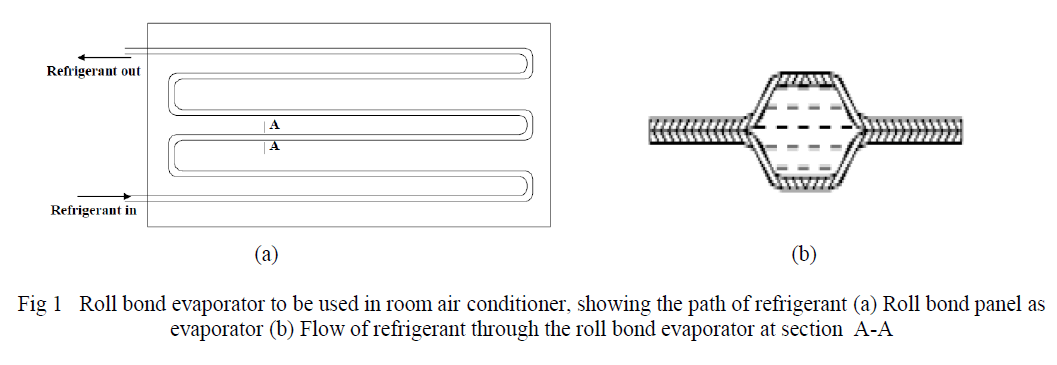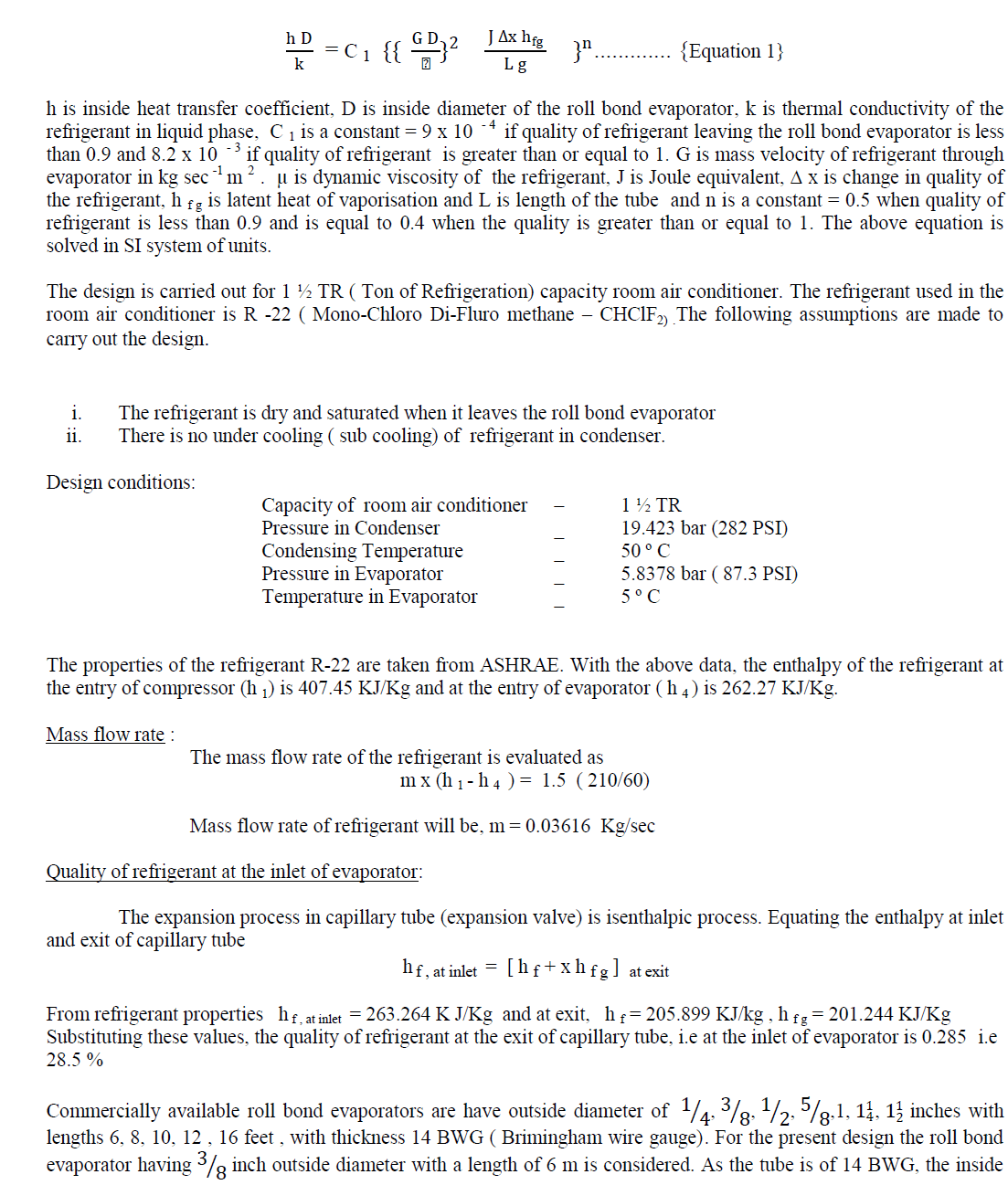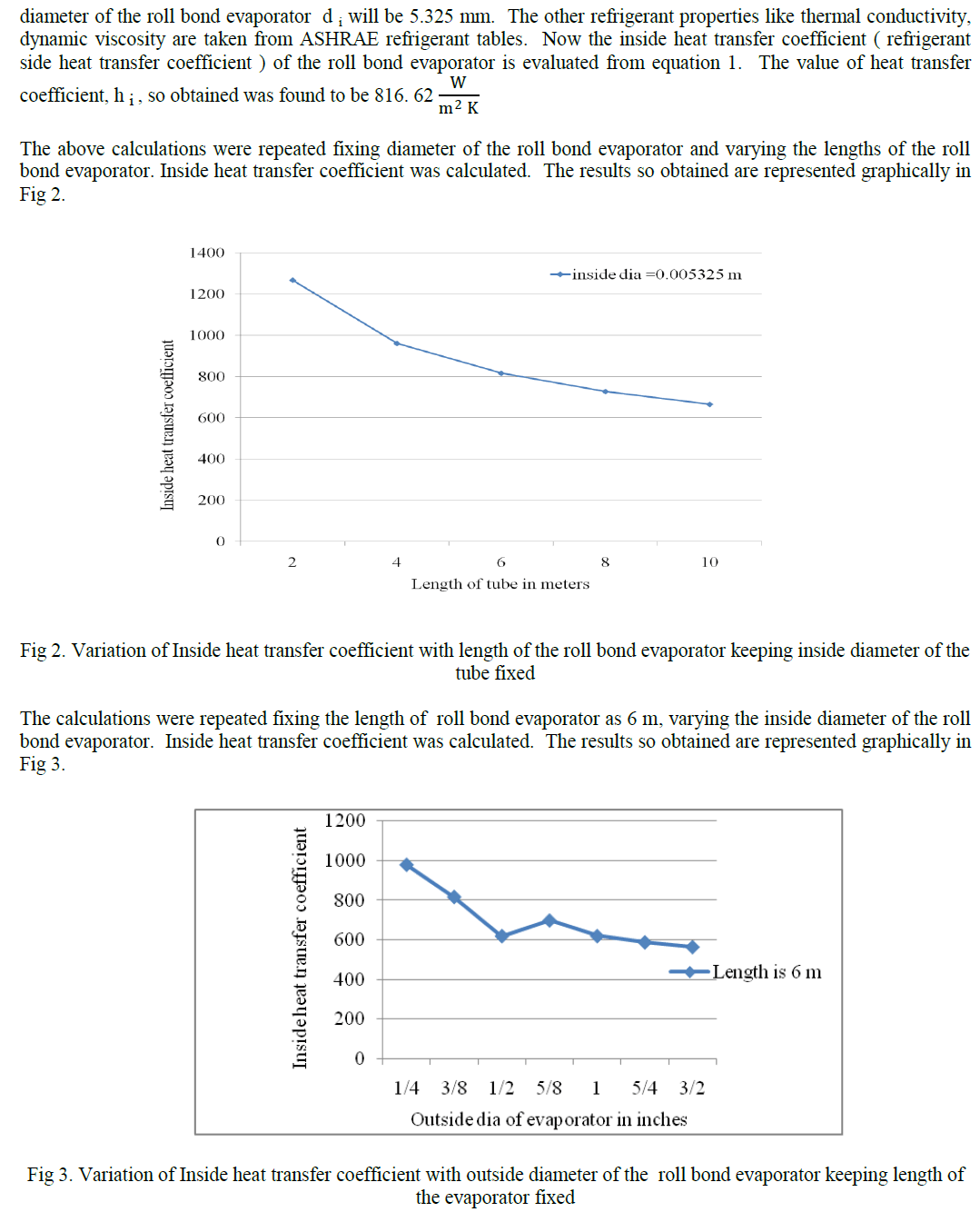ISSN ONLINE(2319-8753)PRINT(2347-6710)
ISSN ONLINE(2319-8753)PRINT(2347-6710)
P.S.Ravi1, Dr Arkanti Krishnaiah2, Dr Suresh Akella3 and Dr Md. Azizuddin4
|
| Related article at Pubmed, Scholar Google |
Visit for more related articles at International Journal of Innovative Research in Science, Engineering and Technology
In all refrigeration and air conditioning equipment the evaporator is either a plate and fin evaporator, tube and fin or a plate and tubular evaporator. There were little changes in manufacturing methods and geometry. This paper presents a new design of evaporator, in which roll bond evaporator is used in room air conditioner. Presently the use of roll bond evaporator is limited to domestic refrigerators only. The study throws light on evaluating the inside heat transfer coefficient ( refrigerant side) of the roll bonded evaporator using R-22 as Refrigerant
Keywords |
| Roll bond evaporator, R- 22, Weld Stop, ASHRAE |
INTRODUCTION |
| In the pursuit of reducing global warming, the world is looking for the methods of reducing energy consumption. In India, appliances working on refrigeration system are one or the major contributing factor to energy consumption. With changing life style and increased standard of living the energy consumption is steadily increasing. Studies have been conducted to reduce the energy consumption by developing higher efficiency products. In a Refrigeration and Air conditioning system, major part of the energy is wasted by the system components compressor, condenser, evaporator and capillary tube due to irreversible processes. The thermodynamic study of these parts has emphasised the need to develop higher efficiency products. A house hold refrigerator or even a room air conditioner has to be designed so as to reduce the losses. In his studies, Jakobsen [1] has concluded that the losses in a Refrigeration and Air conditioning system are mainly in compressor and in the evaporator. In India, the most widely used evaporator in refrigerators is either a plate and tube evaporator or a roll bond evaporator. In air conditioners, tube and fin evaporator is widely used. In this study, roll bond evaporator is used in room air conditioner instead of tube and fin evaporator. . The heat transfer characteristics of the refrigerant is studied and inside heat transfer coefficient refrigerant side) is evaluated. |
| Roll bond evaporators deliver efficient thermal performance. It evaporator is fabricated by rolling together two sheets of aluminum applying heat and pressure during the rolling process such that the two sheets are effectively welded together into a single sheet. By applying special coating called “weld stop” or a chemical ink between the sheets prior to the rolling/welding operation, it is possible to prevent the two sheets from welding together in the areas where the coating is applied. |
 |
| Thus by applying the coating in a serpentine pattern, it is possible to create a serpentine shaped un-welded region within this welded part. By subsequently applying hydraulic pressure to this un-welded region, it is possible to inflate the un-welded serpentine region to form a serpentine passage through the plate. Thus a plate with an integral serpentine passage can be created in a very cost effective manner. Except for the passage the evaporator plate is primarily flat. One end of the evaporator plate is connected to the exit of expansion valve and the other end to the compressor inlet. The refrigerant passes through the channel and produces the desired refrigeration effect. |
BACKGROUND |
| A lot of work has been done earlier on suitability of roll bond evaporator as a heat exchanger device. Numerical models were developed and simulation is carried out. Different manufacturing methods of roll bond evaporator were explored. |
| Siviero, Roberto [2], in their invention, used a roll bond evaporator for use in refrigerator appliance, in a domestic refrigerator. They have stated that the roll bond technique makes the manufacture of refrigerant circuit simple. Even though there might be some short comings in this method, a skilled art makes the roll bond evaporator to be more suitable for the appliance. |
| A.G. Janos[3] , in his patent presented that the evaporator structure which is of roll bonded type is suitable for general refrigeration application. He has provided a method of manufacturing a roll bond evaporator having a heater wire, which forms an integral part of it. This helps in defrosting. |
| Fieramonte, Luigi [4], in their patent experimentally found out that the performance of a refrigerator container increases drastically with the use of roll bond evaporator. They conducted experiments on using different materials of different thickness for manufacture of roll bond evaporator and found an optimum solution to increase the performance of refrigerator container. |
| Anthony J. Cesaroni, Clarance W.Fulton [5], in their patent used a roll bonded metal sheets for making a non planar article. They have demonstrated that this article can be used for automotive heat shield which protects the occupants of any automobile from excessive heat developed by components of exhaust system. |
| Chandrakant patel [6], in his invention developed a cooling apparatus for a computer sub system. The panel gave maximum cooling when it was configured by a roll bond panel. |
| Diego Castanon Seoane [7], while developing an atmospheric water generator, which includes a refrigeration system proved that the total system gives an optimum performance, if a roll bond evaporator is used for the refrigeration system. |
| Stephen R. Callender [8] had a very interesting observation. He noticed that his family dog always preferred to lie on cool surfaces, like ceramic tiles. In his effort to give comfort to his dog he manufactured a cool surface for the dog to lie on. He observed that the cooling is uniform when the plate is manufactured by roll bonding technique. |
| JB Thomas [9] has given a detailed account on the method of making evaporators for refrigerators and similar devices. He has further stressed on annealing process so as to give high strength to the panel. |
| Yilmaz, Turan [10], in their patent gave a different method of production of plate tube type of evaporator. They claimed that the evaporator produced by this process has high heat conductivity |
| DE IZPARILNIKI [11], in their specification catalogue gave different varieties of roll bond evaporators which fit for different refrigerating systems. The specifications are with respect to the materials used, type of cross section, thickness etc. |
| Wei Yang and Jyhwen Wang [12] , in their study have found that diffusion process which is a primary mechanism for roll bonding of metals sheets will be more compact if it is done by warm rolling process. |
| Christian J.L Hermes, Claudio Melo, Cezar O.R. Negrao [13], have studied the importance of using a roll bond evaporator in refrigerating system. In their journal paper, they have developed a numerical simulation model for plate type roll bond evaporators. They have validated their results with experimental data. |
| A. Wintry, MH Al-Hager, Ali A. Bondok[14] in their Journal paper have done CFD analysis of fluid flow and heat transfer in a Roll bonded Plate type radiator made from Aluminum . They have concluded that this method gives higher heat transfer, Low size of radiator and cheaper manufacturing. |
| Cezar O.R. Regarao, Raul H, Ertal[15], while conducting experiments on domestic refrigerator have developed a Semi Empirical model for steady state simulation of domestic refrigerator. They claimed that this method is simple to evaluate performance of the whole system. |
REFRIGERANT SIDE (INSIDE) HEAT TRANSFER COEFFICIENT |
| The heat transfer in any application can be reduced into a simple equation |
 |
| Where A is Area of the roll bond evaporator, h is convective heat transfer coefficient, Δx is wall thickness, K w is thermal conductivity of wall, and η represents efficiency of fin. The subscripts i and o represents inside and outside of the roll bond evaporator. |
| Evaluation of the inside heat transfer coefficient ( refrigerant side ) can be done either by single- phase heat transfer analysis or by two phase analysis. But in an evaporator, the refrigerant is predominantly in two phase region. Many correlations are available for the analysis. Dittus- Boelter correlation, Petukhov and Popov correlation, Shah’s correlation, Bio – Pierre correlation [, Chato and Wattelet correlation can be used. But the most important relation for refrigerant side heat transfer coefficient is given in ASHRAE Handbook, Fundamentals volume - 7 |
 |
 |
CONCLUSIONS |
 |
| optimum performance. As this roll bond evaporator is to be used in room air conditioner, a length of 4m or 6m is preferred. |
ACKNOWLEDGEMEMT |
| The authors wish to thank and acknowledge the support rendered by Osmania University and Sreyas Institute of Engg & Technology, Hyderabad in preparation of this manuscript |
References |
|